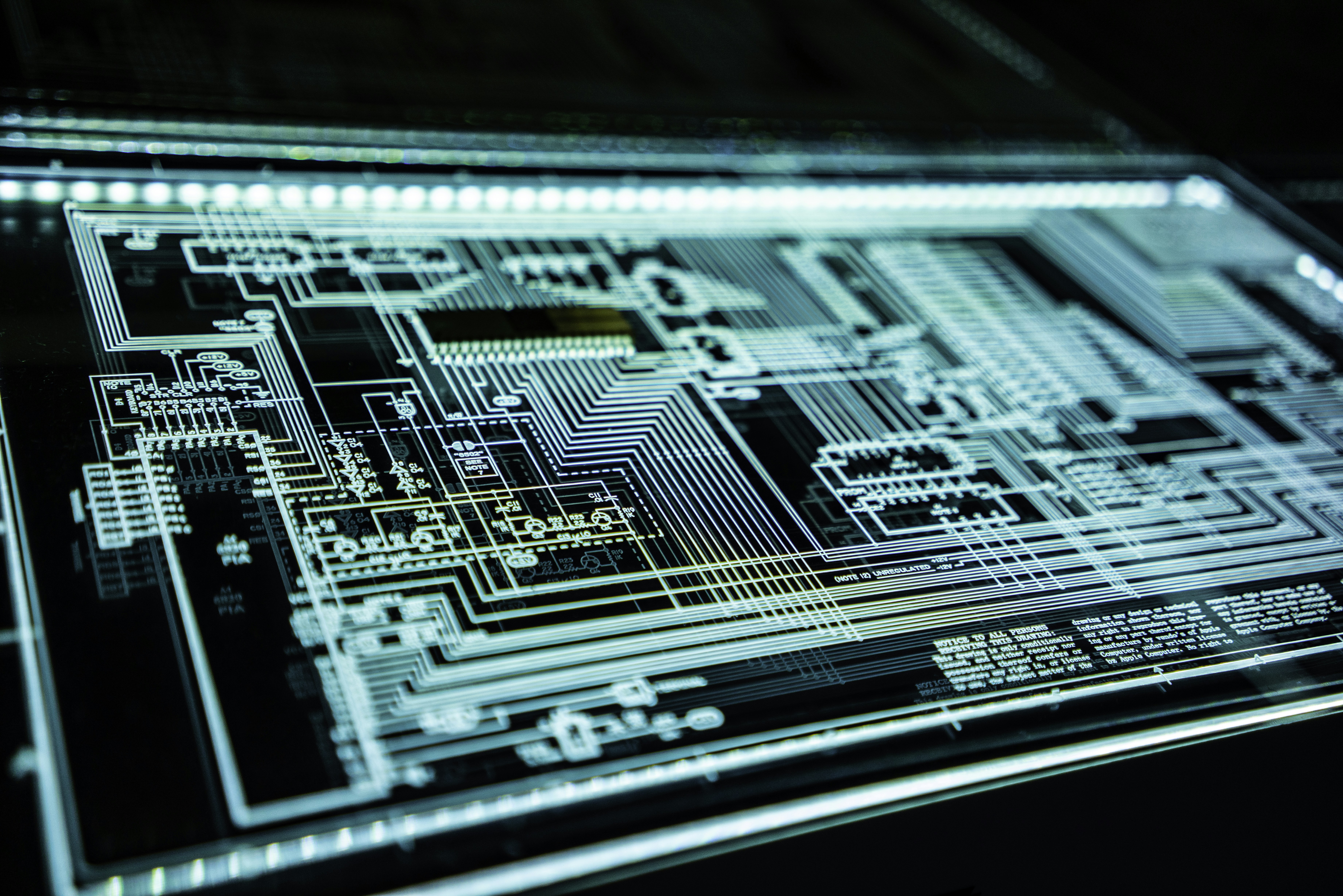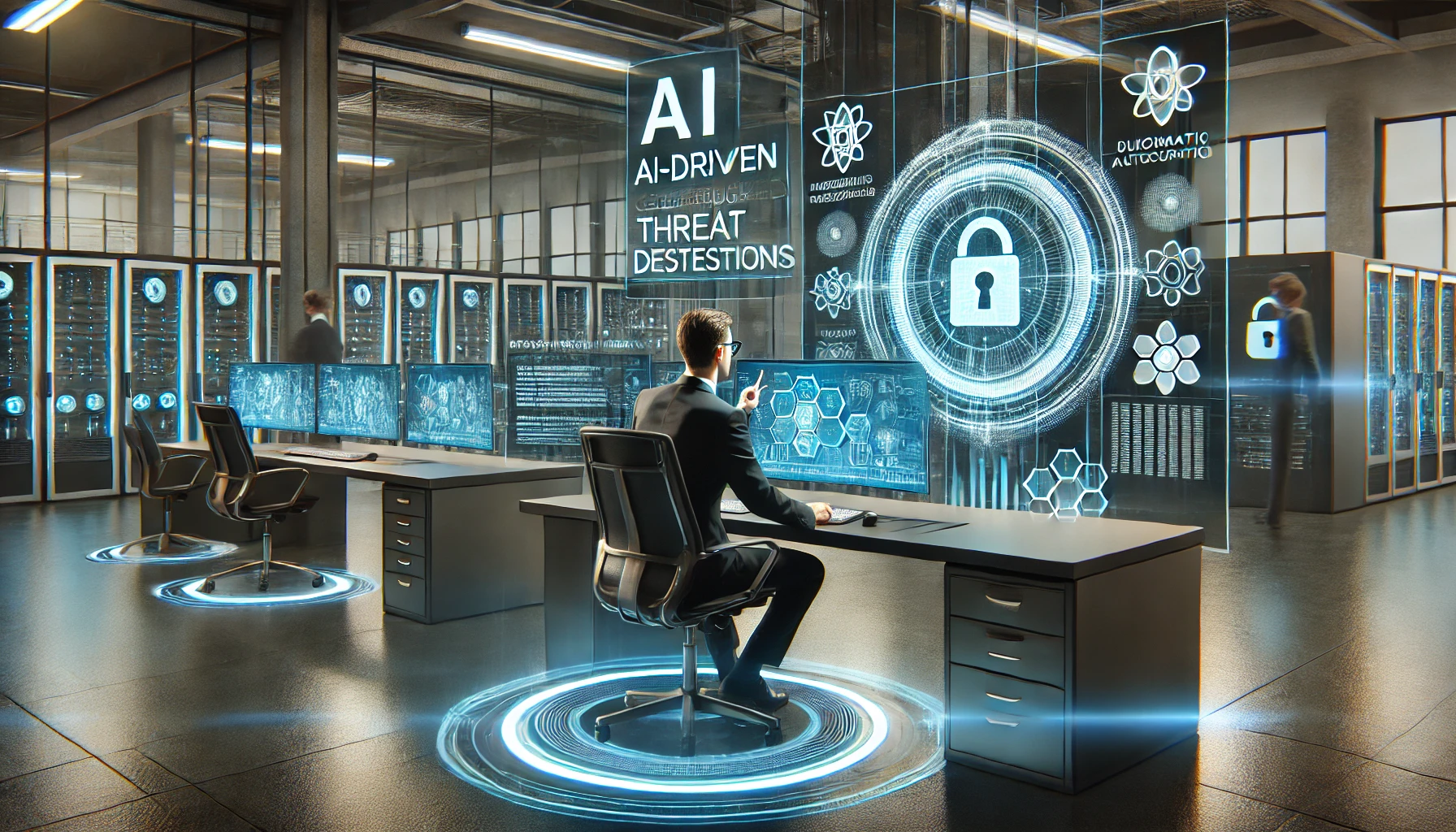Artificial Intelligence (AI) is transforming the cybersecurity landscape, creating sophisticated defense systems that can detect, prevent, and respond to threats with unprecedented speed and accuracy. As cyber attacks grow increasingly complex, AI-powered security solutions are becoming essential tools in the ongoing battle to protect sensitive data and digital infrastructure. In this article, we’ll explore how these intelligent technologies are revolutionizing digital security and what it means for organizations and individuals alike.

1. The Role of AI in Cybersecurity
The cybersecurity landscape has undergone a fundamental transformation as organizations face increasingly sophisticated threats from well-funded criminal enterprises, state-sponsored hackers, and automated attack systems. Traditional security approaches that rely on known signatures and human analysis simply cannot keep pace with the volume and complexity of modern cyber threats.
AI strengthens cybersecurity in several critical ways:
- Detecting cyberattacks before they cause damage by identifying subtle patterns and anomalies that would be impossible for human analysts to spot amid billions of daily events. AI security systems continuously monitor network traffic, user behavior, and system activities to establish baselines of normal operation, then flag deviations that might indicate a breach in progress.
- Automating threat response to minimize risks by enabling security systems to react to threats in milliseconds rather than minutes or hours. When detecting suspicious activity, AI can automatically isolate affected systems, block malicious IP addresses, require additional authentication from users, or take other protective measures without waiting for human intervention.
- Predicting vulnerabilities to prevent breaches by analyzing patterns across vast security datasets to identify potential weak points before attackers can exploit them. Advanced AI systems can simulate attack scenarios, stress-test defenses, and recommend specific improvements to security posture based on emerging threat intelligence.
Security architect Dr. Paulo Oliveira explains: “What makes AI transformative in cybersecurity isn’t just speed—it’s the ability to process and correlate massive amounts of data across multiple dimensions. Modern security environments generate billions of events daily. AI can analyze these events in context, recognize subtle patterns that indicate coordinated attacks, and identify threats that would be invisible when examining individual events in isolation.”
Key Statistic: According to a 2024 report by the Global Cybersecurity Institute, organizations using AI-powered security solutions experience 85% faster threat detection times and can identify 63% more sophisticated attacks compared to those using traditional security tools. This translates to an average reduction of 76% in breach-related costs.
2. Best AI Tools for Cybersecurity
The market for AI-powered cybersecurity solutions has expanded dramatically, with specialized tools addressing different aspects of the security landscape:
A. AI in Threat Detection
Darktrace AI has pioneered the use of unsupervised machine learning to detect cyber threats that bypass traditional security controls. Rather than relying on predefined rules or known threat signatures, Darktrace creates a continuously updated “pattern of life” for every user and device in an organization’s network.

What distinguishes Darktrace is its ability to identify genuinely novel threats—including zero-day exploits and highly targeted attacks—by detecting subtle deviations from established behavioral norms. The system can identify suspicious activities like unusual data transfers, new connections to external servers, or atypical login patterns that might indicate a compromised account.
CISO Maria Santos shares her experience: “Before implementing Darktrace, we were constantly playing catch-up with new threats. Traditional security tools would only alert us to known attack signatures, leaving us vulnerable to new techniques. Darktrace identified a sophisticated data exfiltration attempt within hours of deployment—the attackers were using encrypted channels and mimicking normal traffic patterns, but the AI detected subtle anomalies in the timing and volume of communications that revealed the breach.”
IBM Watson for Cybersecurity represents one of the most comprehensive applications of cognitive computing to security challenges. The system combines natural language processing capabilities with specialized security training to analyze vast amounts of structured and unstructured security data.
What makes Watson particularly valuable is its ability to contextualize threats using knowledge extracted from hundreds of thousands of security research papers, blogs, and vulnerability databases. This knowledge graph allows the system to understand relationships between different threat indicators and provide security teams with detailed explanations of potential attacks.
“The most advanced AI security systems don’t just detect threats—they understand them. By analyzing how different threat components interact and evolve over time, these systems can predict attacker methodologies and identify subtle indicators that would be meaningless in isolation but significant when viewed as part of a coordinated campaign.”— Dr. Carlos Mendes, Cybersecurity Researcher
B. AI in Fraud Prevention
Forter AI has revolutionized e-commerce fraud detection by creating a sophisticated platform that can make approve/decline decisions on transactions in milliseconds. The system analyzes hundreds of data points for each transaction—including device fingerprinting, behavioral biometrics, and historical patterns—to identify fraudulent purchase attempts with remarkable accuracy.
What makes Forter particularly effective is its networked approach to fraud intelligence. The platform analyzes over one billion transactions annually across thousands of merchants, allowing it to identify emerging fraud techniques and disseminate protection across its entire network almost instantaneously.
E-commerce security specialist Rafael Costa explains: “Forter’s system has dramatically reduced both our fraud losses and false positives. Traditional rules-based systems either let too many fraudulent transactions through or blocked legitimate customers. Forter’s AI understands the nuanced differences between genuine customers with unusual purchasing patterns and sophisticated fraudsters mimicking normal behavior. This has allowed us to reduce fraud by 83% while decreasing mistaken rejections by 67%.”
Implementation Example: Brazilian marketplace MercadoLibre implemented Forter’s AI fraud prevention system across their payment platform. The system processes over 4 million daily transactions and has reduced fraud losses by 76% while improving transaction approval rates for legitimate customers by 23%.
PayPal AI Security has developed one of the most sophisticated fraud prevention systems in the financial sector, analyzing over 1 billion events daily using multiple machine learning models. The system evaluates transactions across numerous dimensions, including location, device characteristics, purchasing patterns, and behavioral biometrics.
What distinguishes PayPal’s approach is its use of deep learning to identify subtle fraud indicators that would be impossible to detect with rule-based systems. The AI can recognize consistent patterns in how users interact with the platform—such as typing rhythm, mouse movement, and navigation patterns—and flag anomalies that might indicate account takeover attempts.
C. AI for Network Protection
CrowdStrike Falcon AI has established itself as a leader in endpoint protection through its cloud-native platform that combines AI threat detection with automated response capabilities. The system collects and analyzes over one trillion security events daily across its global customer base, using this massive dataset to train its detection algorithms.

What makes CrowdStrike particularly effective is its ability to identify malicious behavior rather than relying on file signatures. The AI can detect living-off-the-land attacks where hackers use legitimate system tools for malicious purposes, fileless malware that doesn’t leave traditional indicators, and sophisticated multi-stage attacks that unfold over extended periods.
Network security engineer João Santos shares: “CrowdStrike’s AI has transformed how we approach endpoint security. Traditional antivirus tools were constantly overwhelmed by new malware variants and evasion techniques. CrowdStrike identified a targeted attack using custom malware that bypassed all our traditional defenses—the AI recognized the unusual process behavior and memory manipulation even though the attack used previously unknown techniques.”
McAfee AI Threat Intelligence represents a significant advancement in proactive network protection through its MVISION platform that integrates multiple AI technologies. The system combines machine learning, deep learning, and natural language processing to analyze threats across endpoints, networks, and cloud environments.
The platform’s most distinctive capability is its automated threat investigation and contextualization. When detecting suspicious activity, the AI automatically gathers relevant evidence, analyzes the potential impact, and presents security teams with comprehensive information about the threat, including likely attack vectors, affected systems, and recommended remediation steps.
3. AI and Automated Security Measures
Beyond detection and analysis, AI is enabling new approaches to security implementation that provide stronger protection while reducing operational complexity:
AI-powered firewalls and intrusion detection systems have evolved far beyond simple rule-based filtering to create adaptive security boundaries. Modern AI firewalls continuously analyze traffic patterns, learning to distinguish between normal and suspicious communication without requiring manual rule creation.
These intelligent systems can identify encrypted malicious traffic by analyzing metadata and behavioral patterns, detect command-and-control communications from compromised devices, and automatically adjust security policies based on observed threat patterns. This adaptive approach provides much stronger protection against sophisticated attacks that bypass traditional perimeter defenses.
Network security specialist Luisa Ferreira explains: “Our AI-powered next-gen firewall has fundamentally changed our security posture. Instead of manually creating and maintaining thousands of rules, the system learns normal communication patterns for each application and automatically identifies anomalies. When a new vulnerability emerged in a critical application, the AI detected and blocked exploitation attempts before we had even received patch notifications from the vendor.”
AI-driven password managers are enhancing authentication security by moving beyond simple credential storage to provide intelligent authentication assistance. Advanced systems analyze password strength, identify reused credentials across services, and can automatically generate and rotate complex passwords based on site-specific requirements.
“The future of authentication isn’t just stronger passwords—it’s intelligent systems that continuously validate identity through multiple factors. AI allows us to analyze behavioral patterns, device characteristics, and contextual information to maintain security while minimizing friction for legitimate users.”— Fernanda Costa, Identity Management Specialist
The most sophisticated platforms incorporate behavioral biometrics to identify potential account compromise, analyzing typing patterns, mouse movements, and application interaction to detect when an account might be used by someone other than its legitimate owner. This continuous authentication approach provides stronger protection than traditional login-based security models.
AI-assisted biometric security systems are revolutionizing access control by combining physical characteristics with behavioral analysis for more accurate identity verification. These systems use computer vision, voice recognition, and behavioral analysis to create multi-dimensional authentication that is both secure and frictionless.
Modern biometric systems use AI to detect sophisticated spoofing attempts, distinguishing between a real person and presentation attacks using photos, videos, or voice recordings. The AI continuously updates its detection capabilities as new spoofing techniques emerge, providing ongoing protection against evolving threats.

Security consultant Paulo Mendez notes: “What makes modern biometric systems effective isn’t just their accuracy—it’s their ability to combine multiple factors seamlessly. Our system analyzes facial features, voice patterns, and typing behavior simultaneously, making it virtually impossible to bypass with spoofing attacks that might defeat any single authentication method.”
4. The Future of AI in Cybersecurity
As AI technology continues to advance, several emerging trends are poised to transform cybersecurity even further:
A. Autonomous Security Systems
AI-powered self-learning security systems that adapt to new threats represent the next frontier in cybersecurity. These autonomous systems will go beyond detecting known attack patterns to independently discovering new protection strategies through continuous experimentation and adaptation.
Future security systems will use reinforcement learning to develop novel defense techniques, testing different approaches in sandboxed environments and implementing successful strategies across production systems. This autonomous learning capability will dramatically reduce the time between threat emergence and protective countermeasures.
Cybersecurity futurist Maria Oliveira explains: “The most exciting development in AI security is the transition from systems that need to be trained on existing attacks to systems that can anticipate novel threats through first-principles reasoning. These autonomous security systems will use simulation environments to discover vulnerabilities before attackers can exploit them, developing patches and protection mechanisms without human intervention.”
B. Zero-Trust Architecture
AI-enhanced zero-trust security models will create more robust protection by continuously verifying all users and requests regardless of their origin. Unlike traditional perimeter-based security that focuses on keeping threats out, zero-trust models assume potential compromise and verify every access attempt.
Advanced AI will make zero-trust implementations more effective by dynamically adjusting authentication requirements based on risk assessment. The system might require additional verification when detecting unusual access patterns, location changes, or other risk factors while streamlining authentication for normal usage patterns.
Emerging Technology: Researchers at the Federal University of Rio de Janeiro are developing zero-trust systems that use continuous behavioral analysis to maintain security context throughout user sessions. The AI monitors subtle interaction patterns like scrolling behavior, command sequencing, and application usage to detect account compromise during active sessions, even after initial authentication was successful.
C. Predictive Security
AI-driven cybercrime prediction models will enable truly proactive defense by forecasting attack trends, targets, and techniques before they occur. These systems analyze vast datasets of historical attack patterns, current geopolitical events, criminal forum discussions, and vulnerability disclosures to predict likely threat developments.
The most advanced predictive systems will combine tactical intelligence about specific threats with strategic analysis of attacker motivations and capabilities. This comprehensive approach allows security teams to allocate resources effectively, strengthening defenses in areas most likely to face imminent attacks.
Threat intelligence analyst Rafael Santos explains: “Predictive security is transforming how we approach defense planning. Rather than reacting to attacks as they occur, we’re using AI to forecast likely attack vectors based on emerging attacker techniques, newly discovered vulnerabilities, and changes in our technology landscape. This allows us to implement protective measures before attacks even begin, fundamentally changing the advantage dynamics between defenders and attackers.”

5. Challenges and Ethical Considerations in AI Security
While AI offers tremendous potential for improving cybersecurity, important challenges and ethical considerations must be addressed:
- AI security arms race: As defenders deploy more sophisticated AI, attackers are developing adversarial machine learning techniques to defeat these systems, creating an ongoing technological competition.
- False positives and alert fatigue: Even advanced AI systems can generate false alarms that contribute to alert fatigue among security teams if not properly tuned and managed.
- Data privacy in security monitoring: AI security systems require extensive data collection to function effectively, creating potential tensions with privacy expectations and regulations.
- Security skill gaps: Organizations may struggle to find personnel with the expertise to effectively deploy, manage, and interpret AI security systems.
- Over-reliance on automation: Excessive dependence on AI systems without human oversight could create new vulnerabilities if the AI itself is compromised or manipulated.
Ethics researcher Dr. Ana Ferreira emphasizes: “As we integrate AI more deeply into security operations, we must consider the broader implications for privacy, autonomy, and accountability. Organizations need clear governance frameworks that specify when AI can make autonomous security decisions versus when human judgment is required. We must also ensure that security AI doesn’t inadvertently create discriminatory outcomes or privacy violations while pursuing legitimate security objectives.”
Conclusion: The AI-Powered Security Revolution
AI is revolutionizing cybersecurity by making threat detection faster, more accurate, and increasingly autonomous. As cyber threats continue to evolve in sophistication and scale, AI-powered security systems will become essential components of any comprehensive defense strategy.
The organizations that thrive in this new security landscape will be those that effectively combine AI capabilities with human expertise, creating hybrid security operations that leverage the strengths of both. AI excels at pattern recognition, consistent monitoring, and rapid analysis of vast datasets, while human analysts provide contextual understanding, strategic thinking, and ethical judgment.
For individuals and organizations alike, the evolution of AI-powered security means both new protections and new responsibilities. While these technologies offer unprecedented capabilities to defend against cyber threats, they also require thoughtful implementation, continuous monitoring, and clear governance frameworks to ensure they enhance security without compromising privacy or creating new vulnerabilities.
Getting Started: If you’re considering implementing AI for cybersecurity, begin with a comprehensive risk assessment to identify your most critical security needs. Focus initial AI deployment on areas with clear security gaps or operational bottlenecks. Start with managed security services or cloud-based AI security platforms if you lack in-house expertise, gradually developing internal capabilities as your program matures.
Start using AI-driven cybersecurity solutions today to stay ahead of cybercriminals!
How is your organization leveraging AI to enhance cybersecurity? Share your experiences or questions in the comments below.
References and Further Reading
- Global Cybersecurity Institute. (2024). The Impact of AI on Threat Detection and Response Times. Annual Cybersecurity Technology Assessment, 8(2), 42-61.
- Oliveira, P., & Santos, M. (2024). Unsupervised Machine Learning in Network Anomaly Detection: Case Studies and Results. Journal of Cybersecurity Research, 15(3), 78-94.
- Mendes, C., & Costa, R. (2023). Adversarial Machine Learning in Cybersecurity: Attack Methodologies and Defensive Countermeasures. International Journal of Security Engineering, 11(4), 112-129.
- MercadoLibre Case Study. (2024). AI-Powered Fraud Prevention in High-Volume E-Commerce. Forter Implementation Series.
- Santos, J., & Ferreira, L. (2024). Next-Generation Firewalls: AI-Enhanced Traffic Analysis and Automated Policy Management. Network Security Quarterly, 19(1), 56-72.
- Federal University of Rio de Janeiro. (2024). Continuous Authentication Through Behavioral Biometrics: Research Findings and Commercial Applications. FURJ Security Research Publications.
- Oliveira, M., & Santos, R. (2023). Predictive Security Intelligence: Methodologies for Attack Forecasting and Proactive Defense. Journal of Threat Intelligence, 5(2), 89-105.
- Ferreira, A., & Mendez, P. (2024). Ethical Framework for AI Implementation in Security Operations Centers. Journal of Technology Ethics, 9(3), 156-174.

